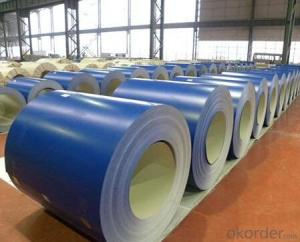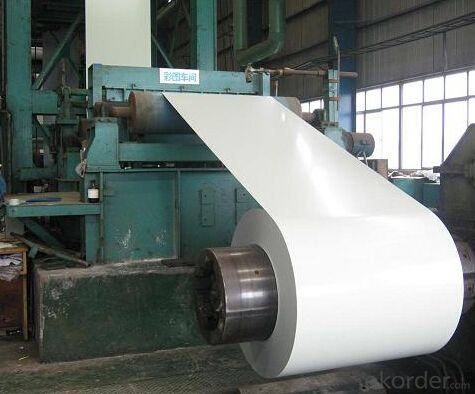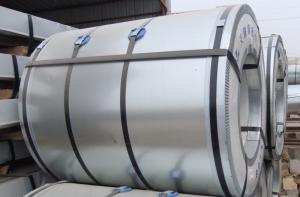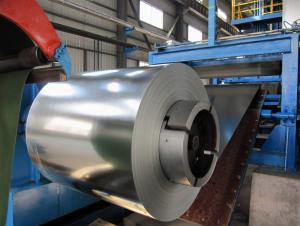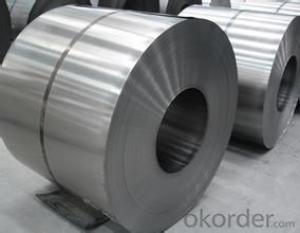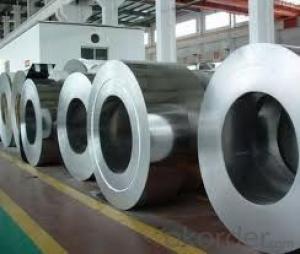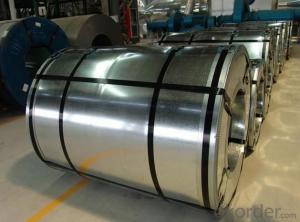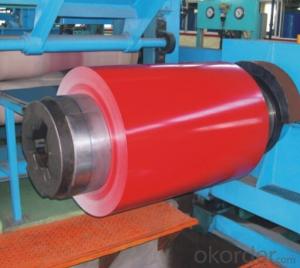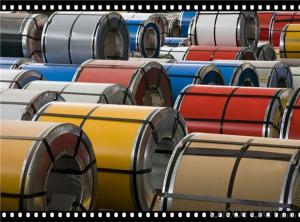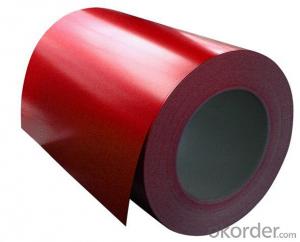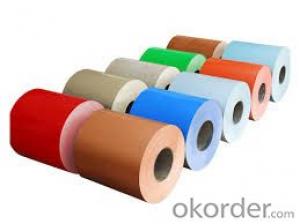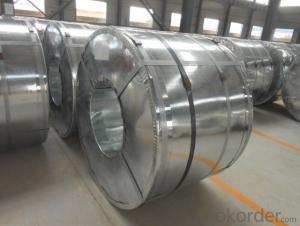Prepaint Galvanized Steel Coil Zinc Coating 30g~ 275g
- Loading Port:
- China main port
- Payment Terms:
- TT OR LC
- Min Order Qty:
- 10 m.t.
- Supply Capability:
- 10000 m.t./month
OKorder Service Pledge
OKorder Financial Service
You Might Also Like
1.Bried Introduction:
1).Colr steel is coated with organic layer, which provides higher anti-corrosion property and longer lifespan than that of galvanized steel sheets.
2).The base metals for color steel consist of cold rooled. HDG lectro-galvanized and hot-dip alu-zinc coated steel. The finish coats for color tels can be classified into groups as follows: polyester, silicon modiied polyesters, polyvinylidene fluoride, high-durability polyester, etc.
3).The production process has evolved from one-coating-and-oe-baking to double-coating-and-double-baking, and even three-coatig-and-three-baking.
4).The color of the color steel has a very wide selection, like orange, creamcolored, dark sky blue, sea blue, bright red, ivory white, procelain blue, etc.
5).The color teels can also be classified into groups by their surface textures, namely regular prepainted sheets, embossed sheets and printed sheets.
2. Steel coil, prepainted steel coil,prepainted galvanized steel coil Advantages:
(1).High strength, Good corrosion
(2).Well rainproof performance
(3). Easy to install and remove
(4).Competitive price with best quality
3.Image of prepainted steel coil:
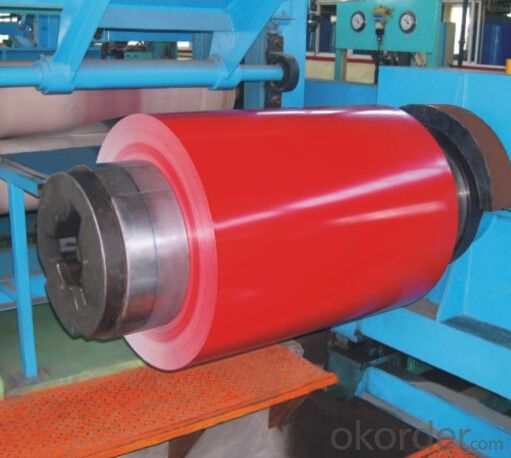
4.Data of prepainted steel coil:
BASE SUBSTRATE | color coated steel coil |
GRADE | SGCC,ENG10142, DX51D, ASTM A653 |
ZINC COATING | 30-200g |
COIL WEIGHT | 3-7TON |
INTERNAL DIAMETER(ID) | 508mm |
THICKNESS | 0.13-2mm |
WIDTH | 600-2000mm |
FINISHING | SMOOTH OR MATTE |
PATTERN | MARBLE GRAIN OR WOOD GRAIN |
PAINT | EXPOXY, POLYESTER, PVDF |
TOP LACQURE COATING | >20 um |
BACK LACQURE COATING | 7 um |
CAPABILITY | 100000 TON per year |
QUALITY QURANTEE | 10 YEARS OF OUTDOOR USING FOR PE |
5.FAQ
We have organized several common questions for our clients,may help you sincerely:
①How about your Warranty?
Warranty: 1-Year for the whole light. Warranty is based on correct storage, installation, using and maintenanc
②How to guarantee the quality of the products?
We have established the international advanced quality management system,every link from raw material to final product we have strict quality test;We resolutely put an end to unqualified products flowing into the market. At the same time, we will provide necessary follow-up service assurance.
③How long can we receive the product after purchase?
In the purchase of product within three working days, We will arrange the factory delivery as soon as possible. The pecific time of receiving is related to the state and position of customers.Commonly 7 to 10 working days can be served.
- Q: I looking at replacing a few of the panels on my car with either Carbon Fiber or High Tensile Steel to shave off some weight and increase mpg and take some time off my quarter mile. Which is better: Carbon Fiber or High Tensile Steel?
- Steel is much cheaper to buy, but weighs more than the carbon fiber and is not as strong as a rule. To save weight on a race car go with carbon fiber. To save weight (money) on the wallet go with steel.
- Q: How are steel coils inspected for surface cleanliness during processing?
- Steel coils are inspected for surface cleanliness during processing using various methods such as visual inspection, magnetic particle inspection, eddy current testing, and ultrasonic testing. These techniques help identify any contaminants, defects, or imperfections on the surface of the coils, ensuring that the final product meets the required quality standards.
- Q: What is the average turnaround time for processing steel coils?
- The average turnaround time for processing steel coils can vary depending on several factors such as the size and complexity of the coils, the specific processing requirements, and the efficiency of the manufacturing facility. However, in general, the average turnaround time for processing steel coils can range from a few days to a couple of weeks.
- Q: How do steel coils resist corrosion?
- A combination of factors contributes to the corrosion resistance of steel coils, including the presence of protective coatings, the utilization of corrosion-resistant alloys, and the implementation of proper handling and storage practices. Galvanization, which involves the application of zinc coatings, is the most common method employed to prevent corrosion in steel coils. This process establishes a barrier between the steel and its surroundings, effectively shielding it from moisture and corrosive elements. The zinc coating acts as a sacrificial layer, taking the brunt of the corrosion instead of the steel itself. Another approach to enhance corrosion resistance entails the use of corrosion-resistant alloys. These alloys are specifically designed to endure harsh conditions and are composed of elements like chromium, nickel, or molybdenum. Upon exposure to the environment, these alloys form a passive oxide layer on the surface of the steel, serving as a protective shield against corrosion. In addition, proper handling and storage practices are crucial in preventing corrosion. It is important to store steel coils in dry and well-ventilated areas to minimize contact with moisture. Care must also be taken to avoid contact with other metals and materials that could result in galvanic corrosion. Regular inspections and maintenance are essential for promptly identifying and addressing any signs of corrosion. In conclusion, the resistance of steel coils to corrosion is achieved through the implementation of protective coatings, the utilization of corrosion-resistant alloys, and the application of proper handling and storage practices. By employing these measures, the longevity and durability of steel coils are ensured in diverse environments.
- Q: What are the different coil packaging options available for steel coils?
- Customers have a range of coil packaging options to choose from for steel coils, depending on their specific requirements and preferences. Some commonly used packaging options include the following: 1. Traditional steel strapping is used to secure the coil, ensuring excellent stability and protection during transportation and storage. 2. Plastic strapping is a lighter and more cost-effective alternative to steel strapping, suitable for smaller and lighter steel coils while still providing sufficient strength and protection. 3. Shrink wrapping involves using heat to tightly seal a plastic film around the steel coil, offering protection against moisture, dust, and other contaminants. 4. Wooden crates provide additional protection against physical damage during handling and transportation. They can be customized to fit the coil's dimensions and secured with straps or nails. 5. Coil covers are heavy-duty plastic or fabric covers that shield the steel coil from environmental factors like UV exposure, moisture, and dust. They are often used in combination with other packaging methods. 6. Paper or fiberboard wrapping offers a lightweight and cost-effective solution for protecting the coil against minor scratches and abrasions. 7. Customized packaging allows for a combination of the above options or tailor-made solutions based on specific requirements. This may involve additional padding, corner protectors, or special handling instructions to ensure safe transportation and storage. Customers should consider factors such as coil size, weight, transportation mode, storage conditions, and budget to choose the most suitable coil packaging option for their needs.
- Q: How are steel coils used in the manufacturing of wires?
- Steel coils are used in the manufacturing of wires by being fed into wire drawing machines, where they are gradually reduced in diameter through a series of dies. The steel coils serve as the initial raw material, providing the necessary strength and flexibility for the wires to be produced.
- Q: can steel boil and turn into a gaseous state?? if so how hot does it have to be for it to boil
- I can't, but it can be done with the right machinery. For iron, it melts at 1538?C (2800?F) and boils at 2862?C (5182?F) Steel is an alloy of iron and various other materials, depending on which alloy it is. The boiling point will depend on the exact alloy and it's composition. Approximate boiling point for common steel is 3000°C (5400°F) .
- Q: Im looking to learn guitar and i was wondering if steel strings are too hard to use as a beginner. I am also self teaching so any good lesson books/starting guitar recommendations are welcome !! thanks.
- Steel strings are fine for a beginner. I learned to play on Steel strings and I have always preferred them to nylon strings.
- Q: How are steel coils used in the production of automotive chassis?
- Steel coils are used in the production of automotive chassis as they provide the primary material for constructing the framework of the vehicle. These coils are first processed and shaped into the desired form, such as beams or plates, which are then welded together to form the chassis. The high strength and durability of steel make it an ideal choice for withstanding the stresses and loads experienced by the chassis, ensuring the safety and structural integrity of the vehicle.
- Q: No. Not Stainless steel, I mean STEEL.Not a specific type, but STEEL.Thanks. xo
- This Site Might Help You. RE: Is Steel a Pure Substance or a Mixture? No. Not Stainless steel, I mean STEEL. Not a specific type, but STEEL. Thanks. xo
Send your message to us
Prepaint Galvanized Steel Coil Zinc Coating 30g~ 275g
- Loading Port:
- China main port
- Payment Terms:
- TT OR LC
- Min Order Qty:
- 10 m.t.
- Supply Capability:
- 10000 m.t./month
OKorder Service Pledge
OKorder Financial Service
Similar products
Hot products
Hot Searches
Related keywords
